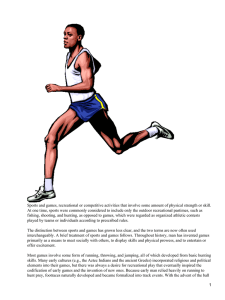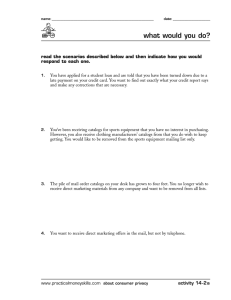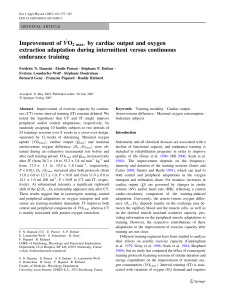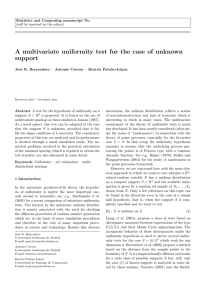Reliability of the maximal oxygen uptake following two consecutive
Anuncio
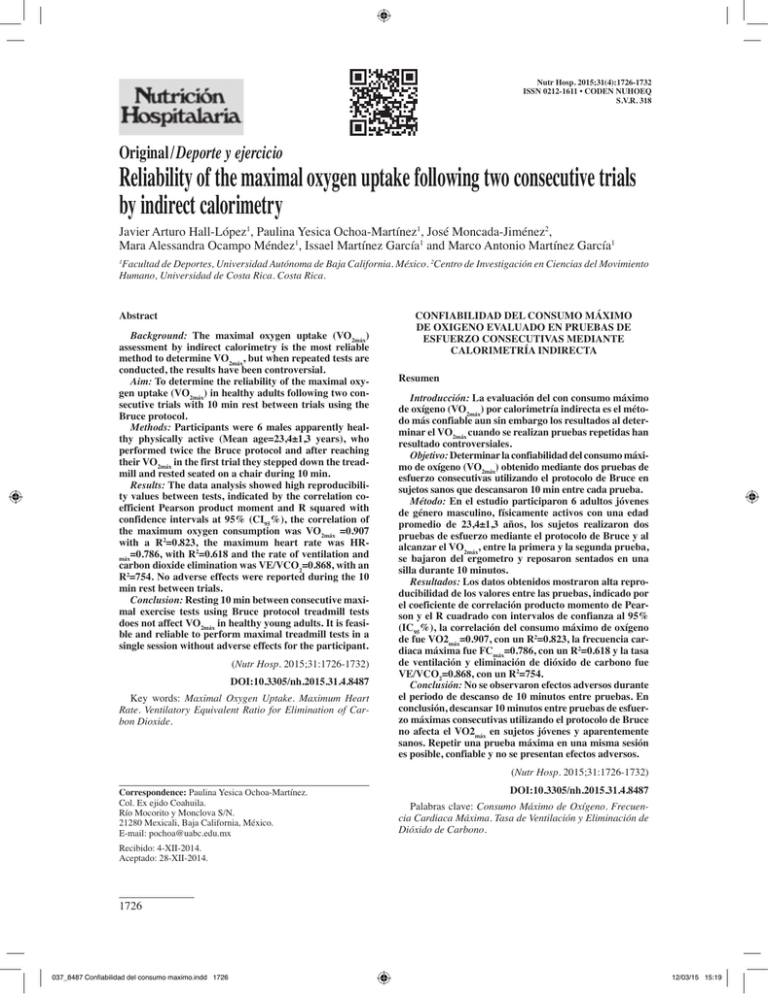
Nutr Hosp. 2015;31(4):1726-1732 ISSN 0212-1611 • CODEN NUHOEQ S.V.R. 318 Original / Deporte y ejercicio Reliability of the maximal oxygen uptake following two consecutive trials by indirect calorimetry Javier Arturo Hall-López1, Paulina Yesica Ochoa-Martínez1, José Moncada-Jiménez2, Mara Alessandra Ocampo Méndez1, Issael Martínez García1 and Marco Antonio Martínez García1 Facultad de Deportes, Universidad Autónoma de Baja California. México. 2Centro de Investigación en Ciencias del Movimiento Humano, Universidad de Costa Rica. Costa Rica. 1 Abstract Background: The maximal oxygen uptake (VO2máx) assessment by indirect calorimetry is the most reliable method to determine VO2máx, but when repeated tests are conducted, the results have been controversial. Aim: To determine the reliability of the maximal oxygen uptake (VO2máx) in healthy adults following two consecutive trials with 10 min rest between trials using the Bruce protocol. Methods: Participants were 6 males apparently healthy physically active (Mean age= 23,4±1,3 years), who performed twice the Bruce protocol and after reaching their VO2máx in the first trial they stepped down the treadmill and rested seated on a chair during 10 min. Results: The data analysis showed high reproducibility values between tests, indicated by the correlation coefficient Pearson product moment and R squared with confidence intervals at 95% (CI95%), the correlation of the maximum oxygen consumption was VO2máx = 0.907 with a R2= 0.823, the maximum heart rate was HR=0.786, with R2=0.618 and the rate of ventilation and máx carbon dioxide elimination was VE/VCO2=0.868, with an R2=754. No adverse effects were reported during the 10 min rest between trials. Conclusion: Resting 10 min between consecutive maximal exercise tests using Bruce protocol treadmill tests does not affect VO2máx in healthy young adults. It is feasible and reliable to perform maximal treadmill tests in a single session without adverse effects for the participant. (Nutr Hosp. 2015;31:1726-1732) DOI:10.3305/nh.2015.31.4.8487 Key words: Maximal Oxygen Uptake. Maximum Heart Rate. Ventilatory Equivalent Ratio for Elimination of Carbon Dioxide. CONFIABILIDAD DEL CONSUMO MÁXIMO DE OXIGENO EVALUADO EN PRUEBAS DE ESFUERZO CONSECUTIVAS MEDIANTE CALORIMETRÍA INDIRECTA Resumen Introducción: La evaluación del con consumo máximo de oxígeno (VO2máx) por calorimetría indirecta es el método más confiable aun sin embargo los resultados al determinar el VO2máx cuando se realizan pruebas repetidas han resultado controversiales. Objetivo: Determinar la confiabilidad del consumo máximo de oxígeno (VO2máx) obtenido mediante dos pruebas de esfuerzo consecutivas utilizando el protocolo de Bruce en sujetos sanos que descansaron 10 min entre cada prueba. Método: En el estudio participaron 6 adultos jóvenes de género masculino, físicamente activos con una edad promedio de 23,4±1,3 años, los sujetos realizaron dos pruebas de esfuerzo mediante el protocolo de Bruce y al alcanzar el VO2máx, entre la primera y la segunda prueba, se bajaron del ergometro y reposaron sentados en una silla durante 10 minutos. Resultados: Los datos obtenidos mostraron alta reproducibilidad de los valores entre las pruebas, indicado por el coeficiente de correlación producto momento de Pearson y el R cuadrado con intervalos de confianza al 95% (IC95%), la correlación del consumo máximo de oxígeno de fue VO2máx=0.907, con un R2=0.823, la frecuencia cardiaca máxima fue FCmáx=0.786, con un R2=0.618 y la tasa de ventilación y eliminación de dióxido de carbono fue VE/VCO2=0.868, con un R2=754. Conclusión: No se observaron efectos adversos durante el periodo de descanso de 10 minutos entre pruebas. En conclusión, descansar 10 minutos entre pruebas de esfuerzo máximas consecutivas utilizando el protocolo de Bruce no afecta el VO2máx en sujetos jóvenes y aparentemente sanos. Repetir una prueba máxima en una misma sesión es posible, confiable y no se presentan efectos adversos. (Nutr Hosp. 2015;31:1726-1732) Correspondence: Paulina Yesica Ochoa-Martínez. Col. Ex ejido Coahuila. Río Mocorito y Monclova S/N. 21280 Mexicali, Baja California, México. E-mail: [email protected] DOI:10.3305/nh.2015.31.4.8487 Palabras clave: Consumo Máximo de Oxígeno. Frecuencia Cardiaca Máxima. Tasa de Ventilación y Eliminación de Dióxido de Carbono. Recibido: 4-XII-2014. Aceptado: 28-XII-2014. 1726 037_8487 Confiabilidad del consumo maximo.indd 1726 12/03/15 15:19 Introduction According to the American College of Sports Medicine (ACSM), in the last couple of decades, stress tests have been widely used in health assessment and sports training in order to determine as a physiological parameter the maximal oxygen uptake (VO2máx),1,2 which is numerically defined as the speed and capacity in which a person breathes air from the environment, is transported by the respiratory and cardiovascular systems, metabolizes oxygen (O2) as a source of energy for muscle cells when carrying out physical activity,3 associated to this process is pulmonary ventilation (VE) and the elimination of carbon dioxide (CO2) numerically defined as the capacity a subject has to ventilate and eliminate CO2 in a minute. This is known as the ventilation rate and the carbon dioxide ventilation and elimination rate.4 With regards to health results of studies, systematic revisions and meta-analysis clearly show that subjects with low VO2máx, values, suffer more from obesity, metabolical and cardiovascular diseases, and premature death.5-8 Related to sports endurance, aerobic capacity is a crucial component of physical capacity in athletes and the VO2máx is a traditionally accepted criteria used to measure aerobic capacity.2 In theory, some authors consider that the maximum aerobic capacity of a person, is the point in which the VO2máx reaches a plateau despite of additional increases in the workloads.3,9 In addition to this, it is also considered a more valid physiological indicator of cardiovascular function in the athlete determined in a lab.10 The criteria used to determine if a person has reached the VO2máx are controversial. Some studies suggest new criteria or recommendations according to the way the research has been designed and the characteristics of the study subjects offering several methodologies to obtain the VO2máx;4,11 Nonetheless, in the clinical and research fields, a consensus is yet to be reached on the criteria to indicate when VO2máx has been reached. For example, there are references which establish different criteria to determine the VO2máx during a stress test, where it is established that the highest value of oxygen uptake in a plateau with an increase in the workload is the main criteria to have reached the VO2máx.12 Another study indicates that when an oxygen uptake plateau is not evident, secondary criteria must be used such as heart rate (FC) and the respiratory exchange ratio (RER) to determine if the subject has carried out his maximal physical effort4. Other research establishes several criteria based on the results to determine that partcipants have reached VO2máx, considering if the assessed subjects complied with at least two of the three possible criteria: a) The the subject reaches the maximum heart rate in beats ·min-1 (FCmáx) according to his age b) That the oxygen uptake value is stabilized as a plateau despite the in- Reliability of the maximal oxygen uptake following two consecutive trials by indirect calorimetry 037_8487 Confiabilidad del consumo maximo.indd 1727 crease of the workload and/or c) That the subject shows values in the RER ≥ 1.15. (Miller, et al. 2007),13 just as it was established in another study that the VO2máx reachable by a subject is fulfilled following these three criteria: a) It is achieved when the subject reaches 95% of the FCmáx in beats·min-1 established for his age; b) When the subject obtains values for RER ≥ 1.05 and c) That the subject voluntarily requests to conclude the test due to exhaustion. Due to the aforementioned, the state of the art with regards to stress tests refers that the absolute and relative criteria to establish when the VO2máx is reached and when to conclude the test continue to be controversial. This because of the fact that some criteria does not correspond to some studies in comparison to others, which shows a contrast or the results are corroborated assessing the same variable which is VO2máx.11,14,15 To determine VO2máx, stress test protocols are carried out by means of an indirect calorimetry system and ergometers (mainly on a threadmill, walking and/or running since this modality uses great muscle mass).3 The Bruce test protocol has been considered for the last couple of decades as the standard test, most widely used in the clinical field and for research studies. This study is composed of 8 continuous 3 minute exercise stages, with increases in the speed and inclination of the treadmill on each stage.16 Despite the fact that the Bruce protocol has been widely used in several subject groups such as children and adults of different ages and genders, as well as in athletes of different sports modalities,10 we still do not know with certainty how reliable physical endurance of a subject can be when the stress test is repeated in the same session to measure using the Bruce protocol. In medicine and sciences applied to sports, the following are considered important criteria for the assessment of physical endurance: validity and reliability of an instrument or measuring test.17,18 Reliability refers to the reproducibility or repetition of values in a test, trial, or measurement in repeated trials in the same individuals. The two most important aspects of error in measurement are concurrent validity and test repetition, where the second most important is the reliability of the reproducibility of the observed value when the measurement is repeated.14,19 Therefore, within this context, the purpose of this present study was to determine the reliability of the maximal oxygen uptake by means of two consecutive stress tests using the Bruce protocol in healthy subjects who rested for 10 minutes between every test. Method Participant Sampling and Selection This present study was approved and recorded in the Office of Postgraduate Studies and Research of the Universidad Autónoma de Baja California (Protocol Nutr Hosp. 2015;31(4):1726-1732 1727 12/03/15 15:19 Nº 149/498 ) and was conducted between August 2013 and August 2014 following a transversal methodological design, with a non-probabilistic sampling by convenience, following the ethical human research principles established by the Declaration of Helsinki.19,20 There was a total of 6 volunteers who were male students from the Bachelor´s Degree Program in Physical Activity and Sports from the Universidad Autónoma de Baja California of ages ranging from 23,4±1,3 years. These students were recruited based on an invitation extended to students from the School of Sports of the Universidad Autónoma de Baja California. There was an appointment scheduled for each one of the students in the Biosciences of Human Motor Skills Laboratory at the School of Sports in the Universidad Autónoma de Baja California in order to request their general information and clinical information, to determine their weight (kg) and height (cm); as well as to conduct an electrocardiogram to rule out any type of cardiovascular condition which would prevent them from participating in the study. They also completed a questionnaire to determine their level of physical activity. Before the stress test section, the participants were asked to wear shorts and a t-shirt for their own comfort, not to carry out any physical activity 24 hours before the test, to be well hydrated, and not to drink or eat anything 4 hours previous to the test. With the purpose of estimating the level of physical activity we used the short format version in Spanish of the IPAQ questionnaire.21 The IPAQ questionnaire provided us with categorical and continuous measurements of physical activity carried out for the last 7 days. The continuous punctuation estimated the weekly energy intake expressed in minutes MET/week (metabolic equivalents). This was obtained by multiplying the value of energy intake for the physical activity according to the frequency per week (days per week) and the time in minutes (minutes per day), considering the modalities of walking at a rate of 3.3 MET, all the moderate intensity physical activity with a value of 4 MET and vigorous physical activity was given a value of 8 MET. The punctuation was classified in 3 categories: inactive, moderately active, and physically active. Subjects who reached the category of physically active were included in this study. The 12 lead electrocardiagram assessment was carried out using the General Electric Company equipment, model: MAC 1200 ST ECG System, Freiburg, Germany®. It was assessed by a doctor, ruling out any type of cardiovascular condition preventing them to participate in a stress test, as per recommendations of the American College of Sports Medicine (ACSM).3 Stress Tests Following the Bruce Protocol The measuring equipment used to carry out the stress tests was a threadmill, a COSMED ergometer 037_8487 Confiabilidad del consumo maximo.indd 1728 Statistical Analysis Statistical analysis was conducted by using (SPSS), version 21.0 for Windows version 21 (IBM Corporation, New York, USA). We carried out a reliability test, calculating the Pearson Product Moment, with confidence intervals at 95% (IC95%). We also calculated the descriptive values of the sum, median, and standard deviation.17 Results Procedure 1728 model T-170 (COSMED Inc. Italy®) and indirect calorimetry was used to measure VO2máx by means of a Quark CPET (COSMED Inc. Italy®) metabolic cart.22 This equipment was calibrated with a mixture of gases of known concentration according to the manufacturer´s specifications (CO2=5%, O2=16%, N2 balance). Heart rate was measured by means of a telemetric device from COSMED Inc. Italy®. Previous to the stress tests the subject became acquainted with the utilization of a COSMED threadmill, model T-170 (COSMED Inc. Italy® where there was a 5 minute warm-up at a speed of 5 km/ h and 0% inclination; the subject at this point was shown the normal functioning of the ergometer and was advised to run in the most comfortable and safest way possible. He was also explained the safety and communication procedures with the assessor. Participants executed the Bruce protocol consisting in starting a stage at the speed of 2.7 km/h at a 10% inclination during 3 minutes, speed and slope changed at 4.0 km/h to 12%, 5.5 km/h to 14%, 6.8 km/h to 16%, 8.0 km/h to 18%, 8.9 km/h to 20%, 9.7 km/h to 22%, and the last stage at 10.5 km/h to a 24% slope. Due to the variety of criteria found in literature to conclude the test, this study considered that the subject achieved VO2máx, after completing two of the following three objectives: a) Request from the subject to cancel the test b) RER ≥ 1.15 values and/or c) VO2 ≤ 2 ml·kg-1·min-1 values with a change of stage. Once the VO2máx, was achieved, a recovery period was allowed where the subject was observed until he reached 80% of the FCmáx in beats·min-1 according to his age. With this criteria we determined that the person had recovered from the physical activity and was requested to begin his 10 minute resting period in which he remained in complete rest. Participants were only allowed to rinse their mouths with water but not to drink it. Once this stage was concluded, we continued with the second stress test. Nutr Hosp. 2015;31(4):1726-1732 All 6 subjects participating in the study were between 23,4±1,3 old. Table 1 shows the descriptive statistics of the maximum oxygen intake variables (VO2máx) expressed in ml·kg-1·min-1, maximum heart rate (FCmáx) expressed in beats per minute (lat·min-1) Javier Arturo Hall-López et al. 12/03/15 15:19 and the ventilation and carbon dioxide elimination ratio (VE/VCO2), obtained in consecutive tests 1 and 2. Figures 1 ,2 and 3 show the calculations obtained to determine the reliability of consecutive stress tests 1 and 2, using the Pearson Product Moment and establishing confidence intervals of 95% (IC95%), in the VO2máx, FCmáx and VE/VCO2 variables. Discussion According to the obtained results when determining the reliability of stress tests when applying the Bruce protocol twice in healthy subjects who rested for 10 minutes between each test, there was a high reproducibility of the values obtained in the variables under study due to the Product Pearson Moment coefficient in maximal oxygen uptake (VO2máx), of 0.907, thus suggesting a 90.7% of the value of the variable between consecutive stress tests 1 and 2. For the maximum heart rate (FCmáx), we obtained the figure of 0.786 which suggests a 78.6% of the value of the variable and the carbon dioxide ventilation and elimination ratio (VE/VCO2) of 0.859. This suggests an 85.9% of the value of the variable, considering that the Pearson Product Moment coefficient is the most widely applied method to establish the interclass reliability coefficient of a test applied twice to the same group of subjects. The values obtained suggest that the variation in the data observed on the first round, match the second. In addition to this, the studied variables reported a square R (R2) also known as the determination coefficient of r=0.823 in the maximal oxygen uptake (VO2máx), a value of r=0.618 in the maximum heart rate (FCmáx) and an r=0 value. The carbon dioxide ventilation and elimination ratio was 754 (VE/VCO2). The value of R2, is a statistical indicator which can show values between 0 y 1. It also graphically indicates a trend the point up to which test values correspond to real data. If the value is closer to 1, R2 is more precise.19 A < from 0 to 0.25 correlation indicates an absence of or a minimal relation, whereas ≥ from 0.25 to 50 indicates a low correlation, ≥ from 0.50 to 0.75 indicates a moderate to good correlation, and > 0.75 indicates a very good correlation.17 There is research attempting to determine the reliability of repeating tests for VO2máx in a threadmill conducted in children. Such tests were applied on the same day with a 7 hour resting period between each one of the sessions. The results show that there were no significant differences in VO2máx between tests. As a conclusion, when using a threadmill it is stable and repeatable, in other words reliable.14 There were 5 stress tests conducted on a threadmill within at least a week apart one from the other and it was concluded that the values found were consistent.15 It is established that the FCmáx reflects the intensity of the physical effort that the cardiovascular system needs to carry out in order to fulfill the increased body demands when engaged in strenuous activity and recovering from such demands varies when resting periods are established from 10 minutes up to a week.4,23 Therefore, the cardiovascular demand in subjects had to be higher in the second stress test in order to be able to reach the previous VO2máx. This might be able to explain the results of the present research of the square R for the maximum heart rate (FCmáx) in beats·min-1 since there was a moderate to good correlation found. In addition to this, oxygen uptake is explained by the Fick equation (VO2=car- Table I Descriptive statistics of the 6 subjects assessed in consecutive stress Sujeto 1ª Prueba VO2máx 2ª Prueba VO2máx 1ª Prueba FCmáx 2ª Prueba FCmáx 1ª Prueba VE/VCO2 2ª Prueba VE/VCO2 A 49.98 52.06 189 186 21.97 20.67 B 48.05 47.5 178 184 21.06 24.48 C 48.26 51.42 188 190 28.1 29.94 D 49.01 51.83 171 179 24.97 27.43 E 47.01 45.68 184 180 20.96 23.02 F 40.13 41.41 173 178 25.36 26.17 Sumatoria 282.44 289.9 1083 1097 142.42 151.71 Media 47.07 48.32 180.50 182.83 23.74 25.29 Varianza 12.6 18.3 58.7 21.8 8.2 10.8 Desviación estándar 3.5 4.3 7.7 4.7 2.9 3.3 Note: The values presented in the assessed subjects are the sum, median, variance and standard deviation of the maximal oxygen uptake (VO2máx ml·kg-1·min-1) expressed in ml·kg-1·min-1, maximum heart rate (FCmáx) in beats·min-1 and the ventilation and carbon dioxide elimination ratio (VE/ VCO2), obtained in stress tests 1 and 2, by means of indirect calorimetry using a Quark CPET metabolic cart (COSMED Inc. Italy®). Reliability of the maximal oxygen uptake following two consecutive trials by indirect calorimetry 037_8487 Confiabilidad del consumo maximo.indd 1729 Nutr Hosp. 2015;31(4):1726-1732 1729 12/03/15 15:19 Fig. 1.—Pearson Product Moment for the VO2máx of assessed subjects (n=6). Note: Figure 1 shows the Pearson Product Moment and the square R of the maximal oxygen consumption (VO2máx ml·kg-1·min-1) in stress tests 1 and 2 indicating a great correlation in the observed subjects.17 Fig. 2.—Pearson Product Moment for the FCmáx in observed subjects (n=6). Note: Figure 2 shows the Pearson Product Moment and square R of the maximum heart rate (FCmáx) in beats·min-1 in stress tests 1 and 2 indicating a moderately good correlation in assessed subjects.17 Fig. 3.—earson Product Moment for the VE/VCO2 found in the study (n=6). Note: Figure 3 shows the Pearson Product Moment and square R for the maximum heart rate (FCmáx) in beats·min-1 for stress tests 1 and 2, showing a good correlation in observed subjects.17 diac output x arteriovenous O2 difference).23 Cardiac output (GC) is the product of heart rate by the systolic volume or the total volume of the blood pumped by ventricles per minute. According to the results, the heart rate increased significantly after the second test. In contrast, the arteriovenous difference of O2 (A-VO2), is determined by the arterial and venous 1730 037_8487 Confiabilidad del consumo maximo.indd 1730 Nutr Hosp. 2015;31(4):1726-1732 contents of O2 exchanged at a cellular level.13,23 We were able to determine from the data obtained from the gases analyzed in the metabolic cart, all the existing links of the different gases during the tests, allowing us to know the values for VE/VCO2. In other words, we were able to determine the proportion between exhaled air and the amount of CO2 pro- Javier Arturo Hall-López et al. 12/03/15 15:19 duced. Their correlation in square R was very good, according to the results there was an increase mainly between the first round and the second assessment. This might occurred due to the fact that when carrying out the vigorous activity, CO2 production increases causing an increase as well in PCO2 and a decrease in body pH. All of which caused an increase in ventilation and sodium bicarbonate production with the purpose of compensating the excessive hydronium ions (H+), making the respiratory and cardiovascular systems least efficient regarding the mobilization of air for each O2.16,23 The square R showed a very good correlation in VO2máx, however average values were higher in the second test than in the first. A justification might be that among the different physiological adaptations when carrying out strenuous exercise, the extraction ability per heart beat is reduced thus reducing the arteriovenous difference of O2. As a result of this, heart rate compensates cardiac output to maintain the same VO2máx during the following Bruce tests.24 This present research presents limitations since neither the systolic volume nor the oxygen pulse (VO2/FC) were assessed. This might have provided us with more discussion elements to establish the causes related to acute physiological adaptations of the cardiovascular system in the subjects after carrying out two consecutive stress tests. However, the design of the study was transversal and the results cannot be used to infer causality and the size of the sample only includes young physically active adults. Despite these limitations, we used indirect calorimetry, which is considered the golden standard to assess aerobic capacity. We were able to obtain important and innovative information contributing to a better understanding for sports performance professionals when assessing aerobic capacity to plan and control workloads in sports training. In contrast, according to the best of our knowledge and after revising the situation, we were unable to find previous research studies were several maximal tests had been conducted in just one session with 10 minutes resting periods between each one of the tests. Due to the aforementioned, after analyzing the different variables and their repercussions in the obtained results, we were able to come to the conclusion that resting for 10 minutes between two maximal tests using the Bruce protocol will not affect the VO2máx reached despite the higher cardiac effort. Repeating a maximal test in the same session is not possible, reliable and there were no adverse effects found in young and healthy subjects. Acknowledgements This research was funded by the Universidad Autónoma de Baja California UABC; Project Number: Protocol N º 149/498. Reliability of the maximal oxygen uptake following two consecutive trials by indirect calorimetry 037_8487 Confiabilidad del consumo maximo.indd 1731 References 1. Greiwe JS, Kaminsky LA, Whaley MH, Dwyer GB. Evaluation of the ACSM submaximal ergometer test for estimating VO2max. Med Sci Sports Exerc 1995; 27:1315-1320. 2. Marsh CE. Evaluation of the American College of Sports Medicine submaximal treadmill running test for predicting VO2max. J Strength Cond Res 2012; 26:548-554. 3. Garber CE, Blissmer B, Deschenes MR, Franklin BA, Lamonte MJ, Lee IM, American College of Sports M. American College of Sports Medicine position stand. Quantity and quality of exercise for developing and maintaining cardiorespiratory, musculoskeletal, and neuromotor fitness in apparently healthy adults: guidance for prescribing exercise. Med Sci Sports Exerc 2011; 43:1334-1359. 4. Midgley AW, Carroll S, Marchant D, McNaughton LR, Siegler J. Evaluation of true maximal oxygen uptake based on a novel set of standardized criteria. Appl Physiol Nutr Metab 2009; 34:115-123. 5. Ramírez Lechuga J, Muros Molina JJ, Morente Sánchez J, Sánchez Muñoz C, Femia Marzo P, Zabala Díaz M. Efecto de un programa de entrenamiento aeróbico de 8 semanas durante las clases de educación física en adolescentes. Nutr Hosp 2012; 27:747-54. 6. Barry VW, Baruth M, Beets MW, Durstine JL, Liu JH, Blair SN. Fitness vs. Fatness on All-Cause Mortality: A Meta-Analysis. Progress in Cardiovascular Diseases 2014; 56: 382-390. 7. Blair SN, Kampert JB, Kohl HW, Barlow CE, Macera CA, Paffenbarger, RS, Gibbons LW. Influences of cardiorespiratory fitness and other precursors on cardiovascular disease and all-cause mortality in men and women. JAMA 1996; 276:205210. 8. Kodama S, Saito K, Tanaka S, Maki M, Yachi Y, Asumi M, Sone, H. Cardiorespiratory Fitness as a Quantitative Predictor of All-Cause Mortality and Cardiovascular Events in Healthy Men and Women A Meta-analysis. JAMA 2009; 301: 20242035. 9. Astorino TA, White AC. Assessment of anaerobic power to verify VO2max attainment. Clin Physiol Funct Imaging 2010; 30:294-300. 10. Leboeuf SF, Aumer ME, Kraus WE, Johnson JL, Duscha B. Earbud-based sensor for the assessment of energy expenditure, HR, and VO2max. Med Sci Sports Exerc 2014; 46:1046-1052. 11. Midgley AW, McNaughton LR, Polman R, Marchant D. Criteria for determination of maximal oxygen uptake: a brief critique and recommendations for future research. Sports Med 2007; 37:1019-1028. 12. Howley ET, Bassett DR, Welch HG. Criteria for maximal oxygen uptake: review and commentary. Med Sci Sports Exerc 1995; 27:1292-1301. 13. Miller GS, Dougherty PJ, Green JS, Crouse SF. Comparison of cardiorespiratory responses of moderately trained men and women using two different treadmill protocols. J Strength Cond Res 2007; 21:1067-71. 14. Amorim, PRS, Byrne NM, Hills AP. Within- and Between-Day Repeatability and Variability in Children’s Physiological Responses During Submaximal Treadmill Exercise. Research Quarterly for Exercise and Sport 2009; 80:575-582. 15. Fielding RA, Frontera WR, Hughes VA, Fisher EC, Evans WJ. The reproducibility of the Bruce protocol exercise test for the determination of aerobic capacity in older women. Med Sci Sports Exerc 1997; 29:1109-1113. 16. Mcinnis KJ, Balady GJ. Comparison of Submaximal Exercise Responses Using the Bruce Vs Modified Bruce Protocols. Med Sci Sports Exerc 1994; 26:103-107. 17. Hopkins WG. Measures of reliability in sports medicine and science. Sports Med, 2000; 30: 1-15. 18. Castro-Piñeiro J, Ortega FB, Keating XD, González-Montesinos JL, Sjöstrom M, Ruiz JR. Valores de percentiles de los tests de campo de capacidad aeróbica en niños de 6 a 17 años; influencia del peso corporal. Nutr Hosp 2011; 26:572-578. Nutr Hosp. 2015;31(4):1726-1732 1731 12/03/15 15:19 19. Hopkins WG, Marshall SW, Batterham AM, Hanin J. Progressive Statistics for Studies in Sports Medicine and Exercise Science. Med Sci Sports Exerc 2009; 41:3-12. 20. Puri KS, Suresh KR, Gogtay NJ, Thatte UM. Declaration of Helsinki, 2008: Implications for stakeholders in research. J Postgrad Med 2009; 55:131-134. 21. Craig CL, Marshall AL, Sjostrom M, Bauman AE, Booth ML, Ainsworth BE, Oja P. International physical activity questionnaire: 12-country reliability and validity. Med Sci Sports Exerc 2003; 35:1381-1395. 1732 037_8487 Confiabilidad del consumo maximo.indd 1732 Nutr Hosp. 2015;31(4):1726-1732 22. The Quark CPET, Metabolic cart for Pulmonary Gas Exchange & 12-lead Stress Testing ECG for research grade analysis, The Quark CPET for research grade analysis, 2014, (COSMED Inc. Italia®). 23. Wilmore J, Costill D, Kenny LW. Physiology of Sport and Exercise (4th Ed.). Champaign, IL: Human Kinetics. 2008. 24. Chia M, Aziz AR. Modelling oxygen uptake in athletes: alometrics scalling versus ratio – scaling in relation to body mass. Annals of the Academy of Medicine of Singapore 2008; 37:300-306. Javier Arturo Hall-López et al. 12/03/15 15:19
